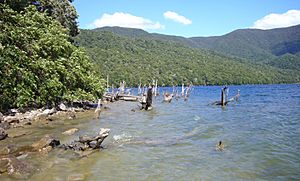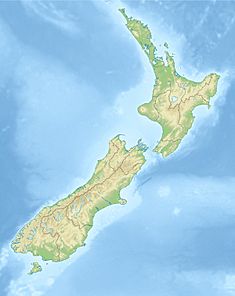Monowai Power Station facts for kids
Quick facts for kids Monowai Power Station |
|
|---|---|

Stumps from dead trees that were drowned when the lake level was raised in the 1920s
|
|
|
Location of Monowai Power Station in New Zealand
|
|
| Country | New Zealand |
| Location | Southland |
| Coordinates | 45°48′42.1″S 167°31′20.6″E / 45.811694°S 167.522389°E |
| Purpose | Power |
| Status | Operational |
| Construction began | 1920 |
| Opening date | 1925 |
| Owner(s) | Southland Electric Power Board (1920-1936) Southland Electrical Power Supply (1936-1993) The Power Company (1993-1999) Trustpower (1999-2002) Pioneer Energy (2002-present day) |
| Operator(s) | Pioneer Energy |
| Dam and spillways | |
| Type of dam | Earth |
| Impounds | Monowai River |
| Reservoir | |
| Creates | Lake Monowai |
| Surface area | 31 km2 (12 sq mi) |
| Normal elevation | 180 m (590 ft) |
| Power station | |
| Name | Monowai Power Station |
| Coordinates | 45°46′32.5″S 167°36′59.7″E / 45.775694°S 167.616583°E |
| Operator(s) | Pioneer Energy |
| Type | Conventional |
| Hydraulic head | 154 ft (47 m) |
| Turbines | Three |
| Installed capacity | 7.6 MW (10,200 hp) |
| Annual generation | 40 GWh (140 TJ) |
| Website Pioneer Energy website |
|
The Monowai Power Station is a hydroelectric power plant in Southland, New Zealand. It uses water from Lake Monowai and the Monowai River to create electricity. It was one of the first power stations of its kind in New Zealand.
The station first started operating in 1925. It was updated between 2005 and 2007 with new, modern equipment. Even with the new parts, the original buildings are still used today. Before the updates, the station made about 6.3 megawatts (MW) of power. Now, it can produce up to 7.6 MW.
Contents
Where is the Monowai Power Station?
The power station is about 50 kilometres from the town of Tuatapere in Southland. You can get to it by following Turbine Drive, which connects to Blackmount-Redcliff Road via Lake Monowai Road.
How the Monowai Power Station Was Built
Starting Construction in the 1920s
Building the power station was a huge job! About 5,000 tons of materials needed to be brought to Monowai. The closest train station was in Tuatapere. Workers used a traction engine (a type of steam-powered tractor) and two trucks to move everything. This meant they had to build and improve roads to the construction site. Before the roads were ready, horses pulled wagons to bring in materials.
In 1920, Alfred Pryde Walker, an experienced engineer, was put in charge of the building project. By the end of that year, 80 men and 40 horses were working hard. They built roads and prepared the areas for the construction camp and the powerhouse. A small water wheel was even set up to provide power for the camp.
By early 1921, the main road to Lake Monowai was finished. A new suspension bridge was also built over the Waiau River. Before the bridge, a ferry carried workers and materials across the river.
Facing Challenges and Restarting Work
In 1921, there was a worldwide economic slowdown. This made it harder for the project to get money. The government asked for costs to be cut. As a result, many workers (112 men) were let go from the Monowai project.
However, a loan was secured in July 1921, which helped the project continue. Herbert P. Thomas became the new engineer in January 1922. He looked at the plans again and made some important changes.
Thomas suggested building a short dam to control the Monowai River. Then, a second, longer earth dam would be built to raise the lake level. Water would flow through control gates into a special area called a headpond. From there, a canal would carry the water to a steel pipeline. This new plan was approved.
Work started again in early 1922. Soon, about 800 people were working on the site, sometimes in three shifts a day!
Building the Dam and Pipeline
Workers built a raised track across the lake's natural outlet to carry materials for the control gates. Once the gates were done, the area was filled with earth to form the dam. The dam's core was made of steel piles surrounded by clay and timber. The rest was filled with concrete, rock, sand, and silt. The lake side of the dam was covered with rocks to protect it from waves.
By early 1923, the dam and control gates were finished. As the lake filled up, the water flowed through the new control gates.
Next, they dug the canal using a steam shovel. The dug-out material was used to create banks alongside the canal.
At the end of the canal, they built a forebay structure to direct water into a single pipeline. Steel for the pipeline arrived in June 1923. It was shaped on-site and then coated with pitch and tar to protect it. The pipeline sections were then put together and placed on special supports.
Overcoming Floods and Leaks
In early 1924, heavy rain caused the Waiau River to flood the powerhouse foundations. This led to a redesign of the foundations to protect the building from future floods. The flooding also damaged the bridge over the Waiau River, requiring a lot of repair work.
When the long pipeline was first filled with water, it bent quite a bit. Workers had to add more supports to fix this. The surge chamber, which helps control water pressure, also leaked at first. A clever solution was found: putting oatmeal in the water, which swelled up and sealed the cracks!
By December 1924, most of the construction was complete. The turbines were running, and the generators were almost ready.
Opening the Power Station
By March 1925, the Monowai Power Station was officially working! It sent electricity to Winton, and then on to Invercargill and Gore. Alfred Walker, the engineer, became the station superintendent.
The station was officially opened on May 1, 1925. It started with two machines. The demand for electricity grew so fast that a third machine was ordered in 1926 and was fully working by February 1928. The total cost of the power station was about NZ$562,000.
Monowai's Journey Through the Years
Operation from 1927 to 1993
By 1934, the power station was struggling to meet the growing demand for electricity, especially from dairy farms using new equipment. There were ideas to increase the station's power, but they didn't happen at that time.
In 1936, the government took over the power station. In 1938, Monowai was connected to the national electricity grid. This meant it was linked to other large power stations in New Zealand.
During World War II, the Monowai power station was considered very important for the country. There were blackouts in the powerhouse and village, and guards watched over the bridge, pipeline, and canal at night.
Over the years, the station had various maintenance and repair jobs. For example, the pipeline was re-tarred in 1942, and the generator windings were repaired several times. In 1955, a small fire briefly closed the station.
New transmission lines were built to connect Monowai directly to Te Anau, improving power supply to that area.
Changes in Ownership
In 1993, the power station became part of a company called The Power Company Limited (TPCL).
Later, in 1998, a new law required electricity companies to separate their power generation from their power lines businesses. Because Monowai was larger than the allowed limit for lines companies, TPCL had to sell it. In 1999, Trustpower bought the station.
Trustpower then sold Monowai to Pioneer Generation (now called Pioneer Energy) in December 2002.
Modernizing the Power Station
When Pioneer Energy bought Monowai, they knew the equipment was old and often broke down. Staff had to be on-site seven days a week during daylight hours. If something went wrong at night, an operator had to drive a long way to fix it.
After looking at different options, Pioneer Energy decided in 2004 to replace all three main systems. New vertical turbines from Sweden and generators from Spain were installed, one each year from 2005 to 2007.
At the same time, the old riveted pipelines were replaced with modern welded steel ones. The new equipment made the station much more efficient. Each turbine now produces 2.6 MW of power, and the station needs much less maintenance.
Some of the old equipment was saved and sold to another company. One of the old turbines and generators was even refurbished and put into use at another small hydroelectric station in New Zealand.
Strengthening the Dam
Since 2003, the Monowai Dam had shown signs of stress during earthquakes. Investigations found problems with how it was built and that some of the timber used inside the dam had rotted.
To make the dam stronger and safer, in 2012, extra support was added to the downstream side. The dam's height was also increased, and the upstream side was covered with more rocks to protect it from waves.
How the Power Station Works
The Monowai Dam is an earth wall built across the Monowai River. It creates Lake Monowai, which is about 31 square kilometres in size. In one part of the lake, four control gates manage the lake's water level.
Water flows from these gates down the Monowai River for about 8 kilometres. It then reaches a headpond, where a weir (a small dam) diverts it into a canal. This canal is about 870 metres long and carries the water to a forebay. The forebay has a gravel trap and a gate to clear it without draining the canal.
From the forebay, a long steel pipeline, about 1.1 kilometres long and 2.6 metres wide, carries the water. This pipeline is raised above the ground on concrete supports. It leads to a surge tank, which is a tall, narrow tower that helps control water pressure.
From the surge tank, three smaller pipes, called penstocks, carry the water downhill for about 60 metres. These pipes connect directly to the Francis turbines in the powerhouse. The turbines spin generators, which create electricity. The electricity is then sent through transformers to increase its voltage for transmission.
The powerhouse is designed so that the Waiau River, where the water flows out, can rise up to 1.5 metres above the power station's floor without stopping its operation.
Operating Rules
The power station has 18 special permits, called resource consents, that allow it to operate. These permits make sure that enough water is left in the rivers and waterways while the station generates power. These permits are valid for another 30 years.


